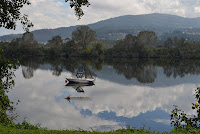 |
| A side street in Tui |
Since we returned from Galicia last October, revisions, dog problems, and health issues in my god-family interrupted my posting about the trip. Because of our dog's age-related condition we are staggering our trips this year, and it occurred to me it's time to finish the post I promised: the trip to Tui, pronounced "Twee". (My husband just came back from his trip to Galicia two and a half weeks ago, and I'm leaving for my trip June 8th. I'll be posting while I'm there, though.)
But—returning to the trip to Portugal last fall—we spent an afternoon in Tui with our friends, David and Terri, on the way back from Porto. Porto, a bay city and a port, is on the Río Douro (the Portuguese name for Río Duero in Spanish); Tui is on the Río Minho (the Portuguese name for Río Miño, and pronounced the same way.) The Río Minho partially divides Spain from Portugal. (You can see a map of the Iberian Peninsula and the
Río Minho HERE ).
 |
| Walking around Tui |
 |
| Typical balconies |
 |
| One view of the Cathedral. |
As is always the case in Iberia, it was a lovely drive from one city to the other. Once we reached Tui, we parked and spent the afternoon walking around. Tui is a cathedral town, as well as an old fortress town from the 12th and 18th centuries. The original city was enclosed by a crenelated stone wall. We started at the old quarter that clusters around the huge cathedral and ancient hospital for the poor (as well as for the
peregrinos, or pilgrims—Tui is one of the pilgrim stops on the way to Santiago de Compostela). The cathedral was started in the 12th century and finished in the 17th century, and thus reflects a variety of architectures. It also has a cloister. And the front entrance, the portal, is truly awesome with fantastic stone statues of saints:



Then we walked from the cathedral area with its adjoining buildings, down to the river, which was smooth as glass. The river walk along the Río Miño turned into a series of reflected scenes, as if on a mirror. On the opposite side was the ancient fortress city of Valença (pronounced Valensa) in Portugal. You can see we had good weather that day.




There was also a small exercise park at one point; a "playground for seniors". And then, just as we thought we were coming to a dead end, we saw a road going back up to the Cathedral. By that time, we were all hungry, and David found a charming cafe (A Muralla) that overlooked another street and had outdoor tables covered by awnings, from which you could also see across to Portugal. (A nice view of the balcony section of the restaurant can be seen at
A Muralla, Tui - Opiniones de restaurantes - TripAdvisor.) The food was delicious. And a very nice waiter took our picture before we left.
 |
| Senior playground? |
 |
| Starting back to the old quarter |
 |
| A great end to the afternoon! |
I hope you enjoyed this little taste of Tui. (Tui is in Galicia, in the province of Pontevedra.) I am always so amazed by the ancient stone buildings, the sculpture work, and the general architecture, that I see in that region. But I suspect much of Europe is like that.
For those of you who have traveled to other parts of Europe, I'd be interested in similarities or differences you've noticed in the places you've visited.













